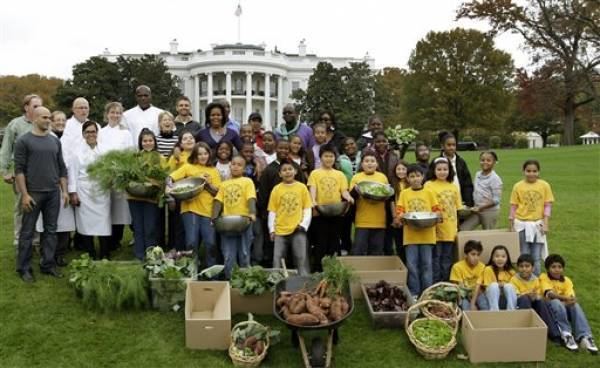 | ||
The White House has had multiple vegetable gardens since its completion in 1800. Eleanor Roosevelt, Hillary Clinton and Michelle Obama all have had their own versions of vegetable gardens. Roosevelt planted the White House victory garden during World War II to promote the use of victory gardens by American citizens in a time of possible food scarcity. Hillary Clinton had a vegetable garden constructed on the roof of the White House. On March 20, 2009 Michelle Obama broke ground on the largest and most expansive vegetable garden to date on the White House lawn.
Contents
- History of White House gardens
- In time of war
- Resistance of vegetable gardens
- Obamas vegetable garden
- Purpose
- Environmental and economic benefits
- Political implications
- Organic versus non organic
- References
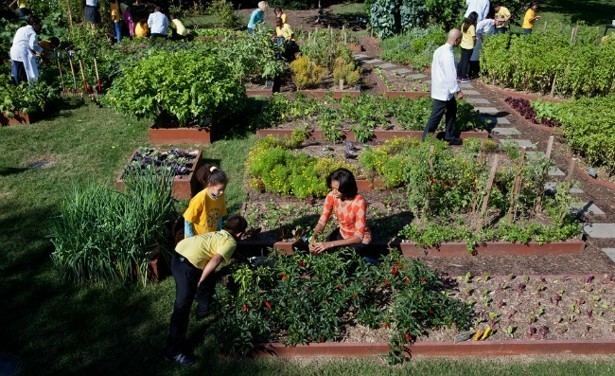
History of White House gardens
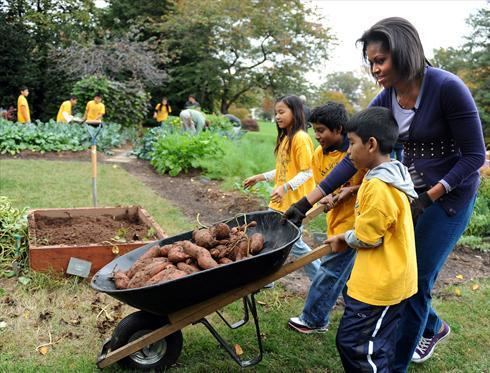
The first White House garden was planted in 1800, by the second president of the United States John Adams and first lady Abigail Adams. Adams and his wife grew their own fresh fruits and vegetables to feed their family, rather than buying produce at the local market. After President Adams planted the first garden, former presidents that lived in the White House cultivated gardens of their own. In 1801, Thomas Jefferson, the second president who resided in the White House, transformed Adams’ garden with the addition of ornamental and fruit trees. Since the grounds of the garden were too raw and muddy for serious planting in the first decade of the 19th century, President Jefferson arranged the construction of his own vegetable garden above Charlottesville so that it would be ready for his retirement. This inspired many American families to plant gardens in their yards. Jefferson also picked the location of the flower garden that was planted. In 1825, Adams was the first president to plant ornamental trees on the White House lawns. He personally planted seedlings such as fruit trees, herbs and vegetables to support his household. Adams also helped develop the flower gardens that Jefferson had originally planted. In 1835 President Andrew Jackson built a hothouse made out of glass, known as the orangery, that grew tropical fruit. The orangery produced fruit from 1836 until it was demolished and replaced by a full-scale greenhouse in 1857. Then several years later the greenhouse was broken down later in 1902 and replaced by the West Wing.
In time of war

The onset of World War I brought the onset of food rationing to the White House. In 1918, President Woodrow Wilson and First Lady Edith Wilson brought sheep to graze and fertilize the lawns. This was a way to save manpower, fuel, and money required to take care of the lawns, because all resources were needed to fight overseas. During World War II in 1943 President Franklin Roosevelt and First Lady Eleanor Roosevelt planted a victory garden on the White House grounds. The victory garden movement started because of food shortages caused by the war. Millions of victory gardens were planted across America during that period of time, producing about 40 percent of America’s vegetables.
Resistance of vegetable gardens
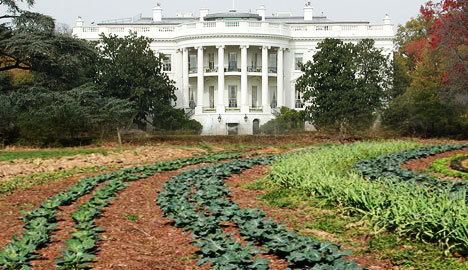
Past efforts of growing vegetable gardens were not always followed through. Jimmy Carter, who was a Georgia farmer and a gardener, talked about how gardening was an important aspect of America’s future in his campaign, but declined calls in 1978 to plant a vegetable garden at the White House. Another unsuccessful attempt was made by President Bill Clinton, who was denied by the White House, saying it was not in keeping with the formal nature of the White House grounds. The Clintons later resorted to planting a small vegetable garden on the roof of the building itself, where produce was grown and used for cooking.
Obama’s vegetable garden
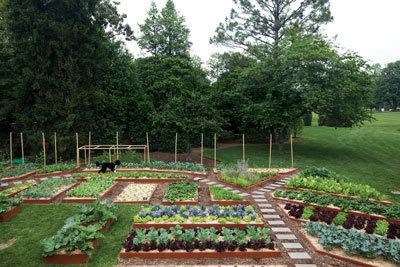
The Obamas planted a vegetable garden on the South Lawn of the White House on March 20, 2009. This L-shaped 1,100-square-foot (100 m2) garden is located by the mansion’s tennis courts and can be seen from E street. The plot provides more than 55 varieties of vegetables along with fruits that are incorporated into meals made for the Obama family as well as invited guests. Another portion of the yields are donated to the local soup kitchen and the Food Bank Organization. There are 55 varieties of vegetables grown, including: arugula (rocket), cilantro (coriander), tomatillo, hot peppers, spinach, chard, collards, black kale, berries and lettuce. In addition to the seeds selected to be planted are twenty five heirloom seeds and ten different herbs such as anise hyssop and Thai basil. Former presidents' favorite produce will also be sown such as President Thomas Jefferson’s preferred vegetables “Brown Dutch and Tennis Ball lettuce, Prickly Seed spinach and Savoy cabbage” but beets will not be grown as President Obama does not like them. Along with the vegetable garden a beehive was added near the chef’s kitchen that is overseen by Charlie Brandts, a beekeeper and White House carpenter. Honey collected from the beehives has been used to brew White House Honey Ale. The contributing gardeners responsible for the early stages of the garden include the First Lady herself, White House Horticulturist Dale Haney, Secretary of Agriculture Tom Vilsack, a team of chefs, and fifth graders from Bancroft Elementary School in Washington. These twenty-three fifth grader advocates, who have grown a garden at their school, helped with digging up the soil, planting, harvesting, and cooking the crops produced. Project facilitator Michelle Obama has made the vegetable garden a priority by requiring hands on assistance from all the family members. In May 2012, the First Lady published American Grown: The Story of the White House Kitchen Garden and Gardens Across America, a book detailing her experiences with the Kitchen Garden and promoting healthy eating.
Purpose

Mrs. Obama, who had no prior experience in gardening, was motivated to start a garden when she realized her daughters Malia and Sasha were not receiving daily nutritious meals. The young girls' diet that would sometimes consist of dining out three times a week with occasional sandwiches for dinner was recommended to be modified by the family’s pediatrician. Mrs. Obama found growing a garden would be an easy way to get more fruits and vegetables in her daughters' diets. The emphasis on the vegetable garden movement is to encourage Americans to increase healthy food choices. The First Lady believes that changes could be made by cooking more at home, eliminating unhealthy foods, and consuming more fruits and vegetables. Furthermore, the garden will take a leading role in educating children about the benefits of local grown produce in attempt to decrease the rising cases of obesity and diet related health issues affecting the nation. Mrs. Obama is confident that by educating the children of this generation then "they will begin to educate their families and that will, in turn, begin to educate our communities.”
Environmental and economic benefits
Foodies and Environmentalist are elated with the produce garden growing at the White House. Michael Pollan, author of the The Omnivore's Dilemma and advocate of sustainable agriculture, believes the garden is not only practical and efficient "but just as important, it teaches important habits of mind – helping people to reconnect with their food, eat more healthily on a budget and recognize that we're less dependent on the industrial food chain, and cheap fossil fuel, than we assume." By growing a vegetable garden at the White house emissions set off through the transportation as well as the additional costs from the purchasing of food products will be reduced. The fertilizers used in the plot are made with “White House compost, crab meal from the Chesapeake Bay, lime and green sand. Ladybugs and praying mantises will help control harmful bugs." The project has also proved to be cost efficient by the roughly two hundred dollars spent on the cost of seeds which will provide a continuous supply of fresh produce year round.
Political implications
The vegetable patch has become a symbolic representation that has encouraged change within current government policies. For example, Secretary of Agriculture Tom Vilsack is now lobbying Congress to review The Child Nutrition and WIC Reauthorization Act in order to change current school lunches. Vilsack will try to persuade the USDA to provide more funds to make more fruits and vegetables accessible to children. The vegetable garden supporters believe the Obamas' role modeling of local sustainable gardening will have a positive effect. The White House’s Executive Chef Walter Scheib is enthusiastic about the fresh ingredients and states, "There has always been a small garden at the White House, but this commitment by Mrs. Obama to a local and freshly grown product is a progressive move forward that will raise the profile and awareness of local and sustainable food both at the White House and nationally to an unprecedented level.”
Organic versus non-organic
Vegetable gardens were non-existent for a long time in the American lifestyle until World War I and World War II when the use and application of gardens was revamped in the shape of victory gardens. These victory gardens were cultivated in one’s own backyard. The victory gardens soon faded to memory after the war but recently have made a comeback. The day Michelle Obama broke ground on the new White House vegetable garden, a letter arrived for her from MACA, Mid-America Croplife Association, urging the Obamas to consider the need for traditional agriculture in America. MACA went on to urge the use effective pest management in their garden, to and increase crop yield so they could feed more people. This idea was further satirized on "The Daily Show" by Jon Stewart. Jeff Stier of the American Council of Science and Health states that it is irresponsible to eat organic, locally grown food because not everyone can afford it. Stier also says that if the Obamas want to be responsible they should use sustainable crop techniques and teach children to use resources wisely to get more produce from their land. Sustainability denotes another controversy between the organic and non-organic gardening. Non-organic garden practices are environmentally responsible, making the most efficient use of resources to produce food, while organic regulations limit people from using the most effective methods of soil conservation and pest management, in favor of using only naturally-derived pesticides, even when they are less environmentally friendly and less effective.
